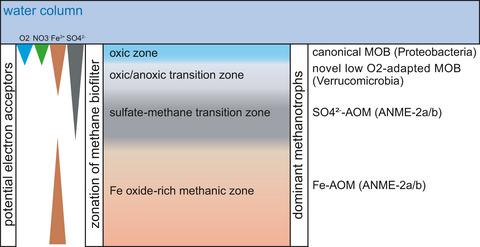当前位置:
X-MOL 学术
›
Microbiologyopen
›
论文详情
Our official English website, www.x-mol.net, welcomes your feedback! (Note: you will need to create a separate account there.)
Enrichment of novel Verrucomicrobia, Bacteroidetes, and Krumholzibacteria in an oxygen‐limited methane‐ and iron‐fed bioreactor inoculated with Bothnian Sea sediments
MicrobiologyOpen ( IF 3.4 ) Pub Date : 2021-02-27 , DOI: 10.1002/mbo3.1175 Paula Dalcin Martins 1, 2 , Anniek de Jong 1, 3 , Wytze K Lenstra 3, 4 , Niels A G M van Helmond 3, 4 , Caroline P Slomp 3, 4 , Mike S M Jetten 1, 2, 3 , Cornelia U Welte 1, 2 , Olivia Rasigraf 1, 3, 5
MicrobiologyOpen ( IF 3.4 ) Pub Date : 2021-02-27 , DOI: 10.1002/mbo3.1175 Paula Dalcin Martins 1, 2 , Anniek de Jong 1, 3 , Wytze K Lenstra 3, 4 , Niels A G M van Helmond 3, 4 , Caroline P Slomp 3, 4 , Mike S M Jetten 1, 2, 3 , Cornelia U Welte 1, 2 , Olivia Rasigraf 1, 3, 5
Affiliation

|
Microbial methane oxidation is a major biofilter preventing larger emissions of this powerful greenhouse gas from marine coastal areas into the atmosphere. In these zones, various electron acceptors such as sulfate, metal oxides, nitrate, or oxygen can be used. However, the key microbial players and mechanisms of methane oxidation are poorly understood. In this study, we inoculated a bioreactor with methane‐ and iron‐rich sediments from the Bothnian Sea to investigate microbial methane and iron cycling under low oxygen concentrations. Using metagenomics, we investigated shifts in microbial community composition after approximately 2.5 years of bioreactor operation. Marker genes for methane and iron cycling, as well as respiratory and fermentative metabolism, were identified and used to infer putative microbial metabolism. Metagenome‐assembled genomes representing novel Verrucomicrobia, Bacteroidetes, and Krumholzibacteria were recovered and revealed a potential for methane oxidation, organic matter degradation, and iron cycling, respectively. This work brings new hypotheses on the identity and metabolic versatility of microorganisms that may be members of such functional guilds in coastal marine sediments and highlights that microorganisms potentially composing the methane biofilter in these sediments may be more diverse than previously appreciated.
中文翻译:

在接种波的尼亚海沉积物的限氧甲烷和铁生物反应器中富集新型疣微菌、拟杆菌和克鲁姆霍尔兹菌
微生物甲烷氧化是一种主要的生物过滤器,可防止这种强大的温室气体从海洋沿海地区大量排放到大气中。在这些区域中,可以使用各种电子受体,例如硫酸盐、金属氧化物、硝酸盐或氧气。然而,对甲烷氧化的关键微生物参与者和机制知之甚少。在这项研究中,我们用来自波的尼亚海的富含甲烷和铁的沉积物接种生物反应器,以研究低氧浓度下微生物甲烷和铁的循环。我们使用宏基因组学研究了生物反应器运行约 2.5 年后微生物群落组成的变化。甲烷和铁循环以及呼吸和发酵代谢的标记基因被确定并用于推断假定的微生物代谢。Verrucomicrobia、Bacteroidetes和Krumholzibacteria被回收,并分别揭示了甲烷氧化、有机物降解和铁循环的潜力。这项工作提出了关于微生物的身份和代谢多功能性的新假设,这些微生物可能是沿海海洋沉积物中此类功能群的成员,并强调可能构成这些沉积物中甲烷生物过滤器的微生物可能比以前认识的更加多样化。
更新日期:2021-02-28
中文翻译:

在接种波的尼亚海沉积物的限氧甲烷和铁生物反应器中富集新型疣微菌、拟杆菌和克鲁姆霍尔兹菌
微生物甲烷氧化是一种主要的生物过滤器,可防止这种强大的温室气体从海洋沿海地区大量排放到大气中。在这些区域中,可以使用各种电子受体,例如硫酸盐、金属氧化物、硝酸盐或氧气。然而,对甲烷氧化的关键微生物参与者和机制知之甚少。在这项研究中,我们用来自波的尼亚海的富含甲烷和铁的沉积物接种生物反应器,以研究低氧浓度下微生物甲烷和铁的循环。我们使用宏基因组学研究了生物反应器运行约 2.5 年后微生物群落组成的变化。甲烷和铁循环以及呼吸和发酵代谢的标记基因被确定并用于推断假定的微生物代谢。Verrucomicrobia、Bacteroidetes和Krumholzibacteria被回收,并分别揭示了甲烷氧化、有机物降解和铁循环的潜力。这项工作提出了关于微生物的身份和代谢多功能性的新假设,这些微生物可能是沿海海洋沉积物中此类功能群的成员,并强调可能构成这些沉积物中甲烷生物过滤器的微生物可能比以前认识的更加多样化。

























 京公网安备 11010802027423号
京公网安备 11010802027423号